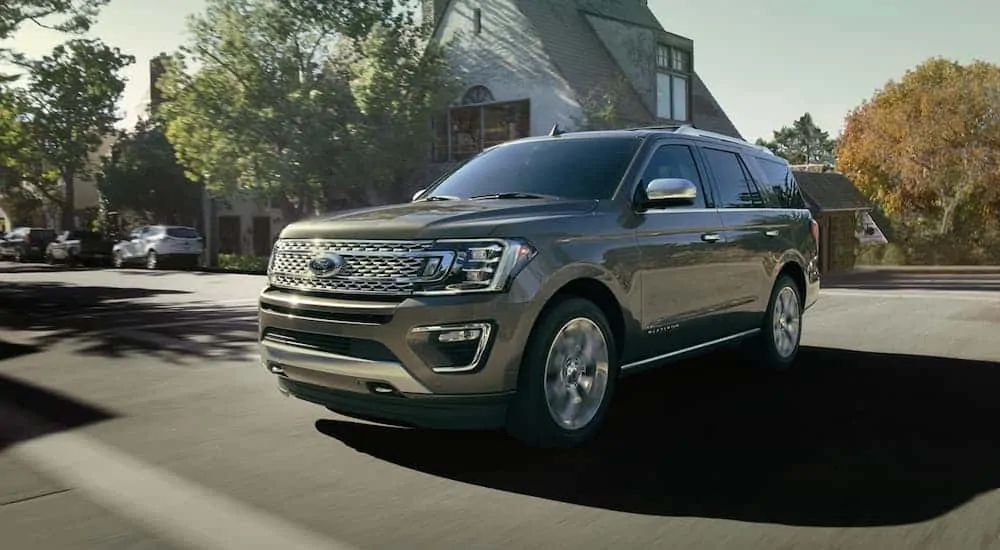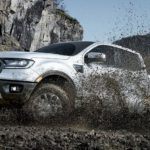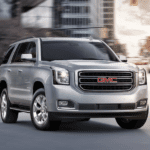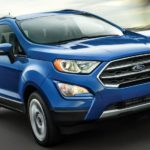Ford and Nissan both have three-row SUVs with off-roading and towing capability, and for drivers hoping to get out for exploring and boondocking with friends or family, a vehicle that can handle both is a must. Here, we’ll compare the features of the 2020 Ford Expedition vs 2020 Nissan Armada, each with four-wheel drive. For Ford, the base XLT trim will be matched against the second-tier SL trim for the Nissan.
Pricing
Here is where the Nissan looks most attractive. With a starting price of $54,900 for the Armada SL four-wheel drive, that’s a nice price for a vehicle that can seat eight and tow a trailer. In comparison, the starting price of $55,820 for the Ford Expedition XLT four-wheel drive is a little higher for just the base trim level.
Engine and Fuel Economy
First, the engines. Ford makes the choice to utilize a turbocharged 3.5-liter V6 with a 10-speed transmission. This transmission does allow for shifting drive modes, and has a two-speed transfer box. Nissan offers a 5.6-liter V8 with a seven-speed transmission, which also allows for shifting drive modes with a two-speed transfer box. You might think the V8 is the way to go when you have such a big vehicle, but the fuel economy alone may change your mind.
When you buy a vehicle as large as the Expedition or the Armada, fuel economy probably isn’t your main concern, but saving any amount of money on gas is a smart investment decision. Nissan made a smart decision on making the price as low as possible because the gas tank will siphon off the remaining funds you would have saved purchasing a different vehicle.
A combined total of 15 MPG is all you get for the Armada with four-wheel drive, with city driving at only 13 MPG and highway at 18 MPG. Ouch. Ford choosing the V6 makes the mileage quite a bit better at a combined score of 19 MPG, with city driving being 17 MPG and highway getting 23 MPG. The gas tank is a big difference, with Ford being the clear frontrunner.
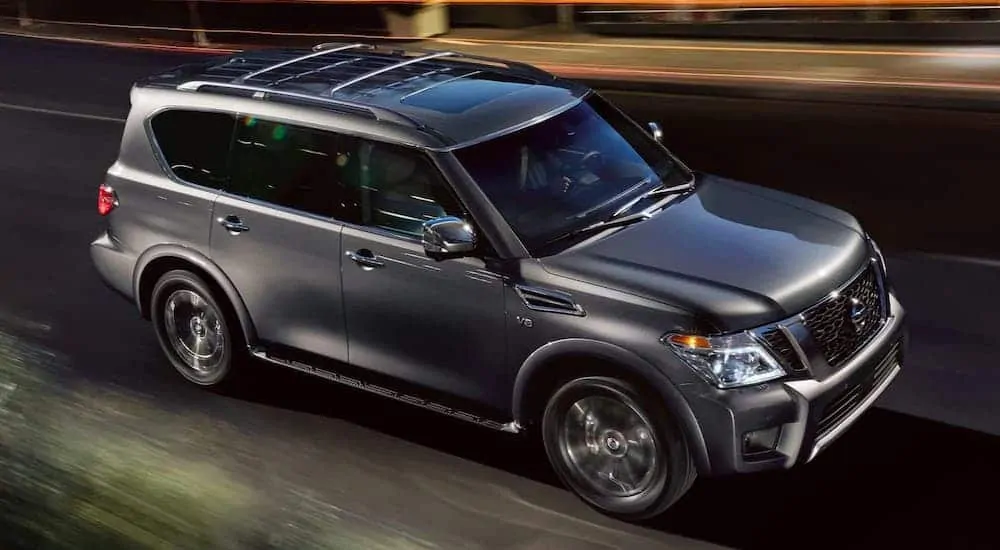
Interior
Even in the lower trims of both these vehicles, you get plenty of high-end quality interior appointments. Nissan gives buyers of the SL a leather steering wheel and seating, powered and heated front seats, driver’s seat lumbar, air filtration, auto-dimming rear-view mirror, audio and cruise controls on the steering wheel, adaptive cruise control, cupholders in all three rows, keyless ignition, dual-zone climate control, a tilting and telescoping steering wheel, and universal remote.
Ford offers buyers of the XLT a leather steering wheel with cloth seating, powered driver’s seat with lumbar, air filtration, auto-dimming rear-view mirror, audio and cruise controls on the steering wheel, cruise control, cupholders in all three rows, keyless ignition, tri-zone climate control, tilting and telescoping steering wheel, and universal remote. Overall, the two vehicles are close to evenly matched, though for the second-tier trim level, Nissan has a slight advantage being compared to Ford’s base trim.
Infotainment
Standard equipment offered for Ford’s XLT trim comes with its Sync 3 system of infotainment, which includes Apple CarPlay and Android Auto, voice recognition software, and hands-free driving. Beyond that, Ford includes a six-speaker audio system, six months of satellite radio, speed-sensitive volume control, an eight-inch infotainment touchscreen, WiFi hotspot, four USB ports, and streaming capabilities.
Nissan’s SL trim comes standard with a 13-speaker Bose system, voice-activated controls for audio, hands-free driving, three months of satellite radio, speed-sensitive volume control, an eight-inch infotainment touchscreen, Bluetooth, four USB ports, and streaming capabilities. Again, the infotainment is fairly close, even though we are comparing base and second-tier trim levels. Clearly, the Nissan has the better stereo, but Ford allows for a Harmon Kardon stereo to be added if it is really important, and Ford includes Apple CarPlay and Android Auto with a WiFi hotspot. Ford has the upper hand there.
Cargo Capacity and Towing
Ford has long been a leader in the field of towing and hauling cargo. Few manufacturers can compare to the capabilities Ford has to offer when it comes to power and control of a heavy load. In this particular category, Ford’s XLT Expedition with four-wheel drive has an edge on the Nissan SL four-wheel drive. Both vehicles need to be upgraded with trailering capabilities; Ford requires the Heavy-Duty Tow package, while Nissan requires the Driver package.
With these packages, the Expedition has a towing capacity of 9,200 pounds, even with the V6 engine, and has a maximum payload of 1757 pounds. Cargo capacity is 19.3 cubic feet with all of the seats in place and expands to 104.6 cubic feet with the seats down. Nissan’s SL only has a towing capacity of 8,500 pounds, with a max payload of 1,583 pounds. Cargo capacity with the seats up is 16.5 cubic feet, and with seats flat, it’s 95.4 cubic feet.
When comparing the features offered for towing, Ford’s heavy-duty towing package includes a heavy-duty radiator, back-up assist, electronic limited-slip differential, and integrated trailer brake controller. Nissan’s Driver package comes with a trailer hitch receiver and pre-wiring, an active brake limited slip system, hill start assist, a tow/haul mode, and four-wheel drive traction control.
Additionally, Ford offers a cargo package which comes with roof rails and an organizer for the trunk area. A cargo package is extra for the Nissan, with both the roof rails and an organizer available, but must be purchased separately.
Off-Road Capability
Once again, this is an area in which Ford tends to dominate. Having the four-wheel drive equipped for both vehicles of this comparison should mean plenty of fun to be had. In the case of off-roading, all the specs that are good for towing are also good for driving through mud and on uneven terrain, but an off-road package needs to be added. To the list of towing capabilities, Ford adds skid plates, a fuel tank underbody protection, all-terrain tires, and off-road front and rear shocks. Nissan’s off-road extras are independent double-wishbone front and rear suspension, auto-leveling rear suspension, skid plates, and all-season tires.
Both vehicles have 360-degree camera systems, which is a huge plus when driving in areas where objects in the environment may reduce visibility. Approach angles for each vehicle are 23.3 degrees for Ford’s Expedition, and 20.9 degrees for Nissan’s Armada. In the case of off-roading, Ford has a vehicle with better capabilities and extras to ensure safety while exploring. Though the Armada has some attractive additions, the Ford heavy duty engine radiator alone is a feature to lend confidence to off-roading, but the added underbody protection is a must when driving on rocky, uneven terrain.
Safety
Both Ford and Nissan have driver-assist safety features included, and both have safety features built into the vehicle body with airbags and design. Ford’s design includes a specialized roll canopy system of side curtain airbags that engage when a rollover occurs, dual-stage front airbags, engine immobilizer to prevent theft, and a post-crash alert system to call authorities for help. Nissan incorporates an energy-absorbing steering column, crumple zones, roof-mounted side-impact airbags with rollover sensor, dual-stage front airbags, an engine immobilizer to prevent theft, and a post-crash alert system.
Driver-assisted safety features for Ford are included under the Ford Co-pilot 360 package, which includes automatic headlights, blind-spot information system, cross-traffic alert, lane-keeping alert and assist, pre-collision assist with auto braking, pedestrian detection, forward collision warning, and a rear-view camera with washer. Nissan’s driver-assisted safety pales in comparison with forward collision warning, auto emergency braking, and the 360-degree camera with motion detection. To gain a fuller package of safety features, it must be added with the Premium package. This category is split, with Nissan getting the upper hand on design, but Ford offering more driver-assisted safety.
Quality vs Cost
In terms of price, Nissan is definitely ahead of the game, but when you add up most of the features of the base level trim of the Ford XLT, there is a lot of power, savings in the gas tank, and plenty of options to mix and match. Nissan has options to be added, too, but some of the standard features of just moving up one trim level could give buyers a lot more from the Ford. Certain aspects will come down to what features matter most to buyers’ tastes, but the capability of the Ford is coming from a long line of trucks and SUVs made to rule the outdoors. In this comparison, the Ford is where you want to go for towing and hauling, as well as safety when you are towing or going off-roading. What the Nissan appears to save on the price may come down to losing the quality of what Ford offers even in the base trim level.
